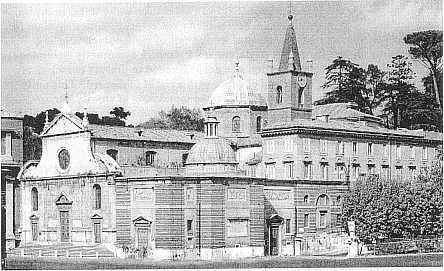Contenuto
Percorso : HOME > English > Pilgrims > St. Mary of the PeopleThe Basilica and the Convent of St. Mary of the People

Rome: the Basilica and the Convent of St. Mary of the People
The Basilica and the Convent of St. Mary of the Peopleá
The Basilica of Santa Maria del Popolo becomes part of the grandiose whole of the harmonious square or piazza of the same name. The fašade and the bell tower are what remain visible of the fifteenth century construction. The Basilica is on the left while the Augustinian convent is on the right.
This place, especially the Convent, is symbolic of the UNITY and DIVERSITY of the Augustinian Order. In the Convent attached to this Church, the Grand Union of the disparate hermit/friars of Tuscany occurred in March of 1256, almost 750 years ago.
The Convento of Santa Maria del Popolo is connected with the origin of the Augustinians as a Mendicant Order. In this place, the first Augustinians, emerging from the eremitical movement, decided to embark upon a new path in the Church, in response to the needs of the time and at the request of Pope Innocent IV. They established themselves, through the initiative of and in obedience to the Holy Father, as an apostolic fraternity, open to the pastoral needs of the People of God and in direct dependence on the Pope so as to collaborate actively in the reform of the Church.
This decision was confirmed here at this Convent with the election of the first Prior General, Lanfranc, at a gathering of the disparate Tuscan groups in March of 1256. In recalling this moment, two points can be underscored as the specific message of this encounter with Augustinian history.
First of all, this place speaks of UNITY. This church was witness to the union of forces of diverse eremitical groups who wished to undertake a new direction. In our visit to this Augustinian site, perhaps we can reflect upon ourselves as representatives of the community of Merrimack College, a community stemming from this root of Augustinian identity. Are not we called to present ourselves at Merrimack as a model of union and of peace with a world of discord? This unity among us is only possible if it is grounded on the foundation of charity. St. Augustine reminds us in Sermon 336: 1-2 that the unity of mind and heart which establishes community is only possible if our roots are in Christ and if our relationships are bound by the virtue of charity ...
The second message of our visit challenges us to reflect opon OPENNESS TO THE CHANGING AND DIVERSE NEEDS of our students, the people to whom we minister at Merrimack. This basilica is witness to a tremendous change of direction and of the courage of our Augustinian forbears who were able to hear the voice of God, as Abraham had, and who were willing to set out to tend the needs of the people of their time and place. In this way, they broke with a kind of 'localism' and opened themselves op to a new sopra provincial and sopra national vision from which ushered forth its most brilliant and promising years. Close to seven hundred and fifty years separate us from this unique moment of Augustinian history and from the foundation which took place in the ancient Church of Il Popolo. Might not the visit motivate us to strive for a greater sense of unity as well as to strive for a deeper understanding of the meaning of diversity at Merrimack College?
While in the Basilica, one might note the many works of art that have been donated and collected over the centuries. Of particular note and interest are the two Caravaggio works of art depicting St. Peter and St. Paul. They are masterpieces well work viewing.

